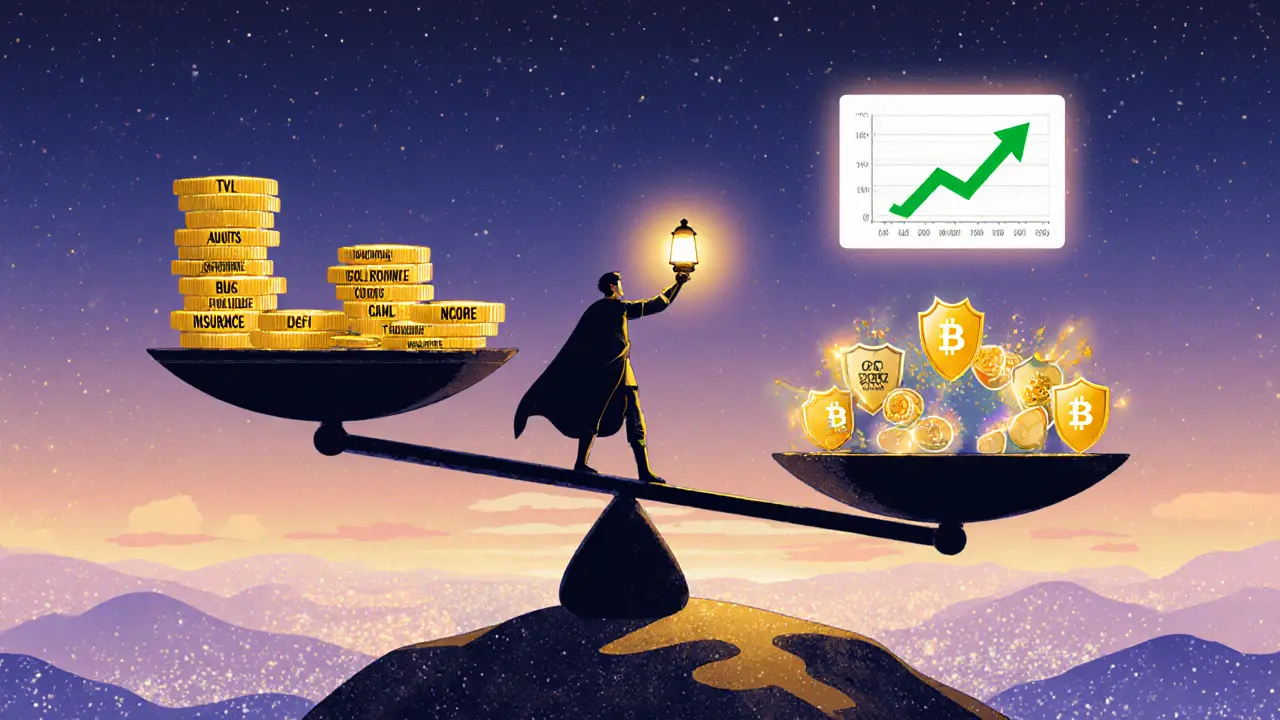DeFi Protocol Safety Checker
Enter values and click Analyze to evaluate protocol safety.
How This Works: This tool evaluates DeFi protocols based on key safety indicators beyond TVL. Consider how much TVL is adjusted for double-counting, whether audits are comprehensive, and if governance is decentralized. High TVL alone does not ensure safety.
DeFi platforms tout billions of dollars locked in their contracts, but does a massive total value locked guarantee safety? Let’s break down what TVL really tells you and what you should look at before trusting a protocol.
- High TVL often reflects user confidence and deep liquidity, but it’s not a safety badge.
- TVL can be inflated through double‑counting, price spikes, or synthetic assets.
- Security audits, governance decentralization, and code quality matter more for protecting funds.
- Combine TVL with active‑user metrics, transaction volume, and audit history for a balanced risk view.
- Emerging multi‑dimensional scores aim to replace raw TVL rankings.
What TVL Actually Measures
Total Value Locked (TVL) is the nominal dollar value of assets currently locked in a blockchain, a DeFi protocol, or a specific smart contract. It adds up funds placed in liquidity pools, staked tokens that secure networks, and capital allocated to yield‑farming strategies. The number is easy to grab from trackers like DeFiLlama, and it’s become a headline metric for every new project.
Why a Big TVL Looks Good at First Glance
When a protocol shows a TVL in the billions, three things happen in a user’s mind:
- Confidence: Investors assume many others have vetted the platform.
- Liquidity depth: Large pools usually mean lower slippage for traders.
- Adoption signal: A high figure suggests real economic activity and a growing ecosystem.
These are genuine advantages. Deep liquidity reduces transaction costs, and a broad user base can help decentralize governance over time.
How TVL Can Mislead You
Despite its appeal, TVL has critical blind spots:
- Double‑counting: Some platforms count the same asset twice-once as a deposited token and again as a derivative token minted on top. Academic studies have shown TVL‑TVR gaps of over $140billion across the ecosystem.
- Price volatility: TVL is calculated using current token prices. A bull market can inflate TVL without any new users, while a bear market can shrink it even if usage stays steady.
- Passive lock‑up: Funds can sit idle in a vault that never moves. High TVL doesn’t mean active trading or robust demand.
- Security ignorance: TVL tells you nothing about whether the protocol has undergone a security audit, whether its code is open‑source, or if governance can be hijacked.
In short, TVL is a “quantity” metric, not a “quality” gauge.
Key Safety Factors That TVL Doesn’t Capture
To assess protocol risk, dig into these dimensions:
- Audit pedigree: Look for reports from reputable firms (e.g., ConsenSys Diligence, OpenZeppelin). Multiple independent audits are a good sign.
- Governance decentralization: A protocol governed by a single private key or a tiny council is a single point of failure. Check the governance model-whether voting power is distributed among token holders.
- Bug bounty programs: Active reward programs indicate the team welcomes external security research.
- Insurance coverage: Some DeFi platforms purchase coverage from Nexus Mutual or similar providers to protect users against hacks.
- Bridge risk: If a protocol operates across chains, examine the security of its bridge. History shows bridges being targeted more often than core contracts.
- Team credentials: Transparent founders and developers with track records reduce the chances of a “rug pull”.

Real‑World Cases: High TVL, Low Safety
Several high‑TVL platforms suffered major breaches, proving the metric’s limits:
- Protocol Alpha (2023): Over $1billion TVL, but a single‑point‑of‑failure admin key was compromised, leading to a $300million loss.
- Yield Farm Beta (2022): TVL peaked at $800million thanks to token price hype, yet the smart contract had never been audited. An exploit drained 60% of the funds.
- Cross‑Chain Bridge Gamma (2024): Claimed $2billion TVL across Ethereum and BSC, but a flawed Merkle proof logic let attackers siphon $120million.
In each case, the TVL numbers gave a false sense of security.
Success Stories: Low TVL, Strong Safety Practices
Conversely, some modest‑TVL platforms have never experienced a hack:
- Protocol Delta: Maintains ~ $50million TVL, runs open‑source code, undergoes quarterly audits, and has a multi‑sig governance model. No incidents reported in three years.
- Lending Hub Epsilon: Holds $120million TVL, but all contracts are verified on‑chain, and the team runs a $2million insurance fund that covered a small bug in 2021.
These examples show that solid security hygiene can outweigh sheer capital size.
How to Evaluate a Protocol Safely - A Practical Checklist
| Factor | What to Look For | Red Flag |
|---|---|---|
| TVL (adjusted) | Adjusted figures from DeFiLlama that remove double‑counted assets | Unusually high TVL relative to peer protocols |
| Security Audits | At least two independent audits, publicly linked reports | No audit or only a single, outdated audit |
| Governance | Decentralized voting, multi‑sig admin, clear proposal process | Single private key control |
| Bug Bounty | Active program with reasonable reward tiers | No bug bounty or closed‑door reporting |
| Insurance | Coverage from reputable mutual or insurer | Zero coverage for smart‑contract risk |
| Bridge Security (if applicable) | Audited bridge contracts, limited upgradeability, proven track record | Custom bridge with no external audit |
| Team Transparency | Public LinkedIn/GitHub profiles, known past projects | Anonymous founders, no code commits visible |
Running through this list helps you see beyond the TVL headline.
Emerging Metrics and the Future of DeFi Safety Scores
Analysts are now blending TVM (total value moved), active‑user counts, governance participation rates, and audit histories into composite scores. Projects like “DeFiScore” and “RiskRadar” provide a single rating that reflects multiple risk dimensions. As the market matures, investors are expected to rely less on raw TVL rankings and more on these holistic dashboards.
Quick Takeaways
- High TVL indicates popularity, not invulnerability.
- Watch out for double‑counted assets and price‑driven swings.
- Prioritize audited, open‑source code and decentralized governance.
- Use multi‑factor checklists or composite scores for a balanced view.
- Stay updated on new safety metrics; the industry is moving beyond TVL.

Frequently Asked Questions
Does a higher TVL always mean a protocol is safer?
No. TVL measures the amount of capital locked, but it says nothing about code quality, audit status, or governance. A high‑TVL project can still be vulnerable to hacks or centralization attacks.
How can I tell if a TVL figure is inflated?
Look for adjusted TVL numbers from trackers like DeFiLlama, check whether the protocol counts derivative tokens, and compare the figure with peer projects. Sudden spikes that don’t match user growth often signal inflation.
What security audits should I trust?
Audits from well‑known firms such as ConsenSys Diligence, OpenZeppelin, Trail of Bits, or Quantstamp carry weight. Ideally, a protocol will have multiple independent audits and a public audit repository.
Are there any metrics that combine TVL with security factors?
Yes. Tools like DeFiScore, RiskRadar, and LlamaScore aggregate TVL, adjusted TVL, audit status, active users, and governance health into a single rating. These composite scores give a more reliable safety picture.
Should I avoid low‑TVL protocols?
Not necessarily. Small‑cap protocols can be very secure if they have strong audits, transparent code, and robust governance. Use the safety checklist rather than TVL alone to decide.


Comments
Parker Dixon
Great overview! 👍 TVL is just one piece of the puzzle; you also want to check audits, open‑source code, and how decentralized the governance really is. A high TVL can still hide a single‑point‑of‑failure admin key, so I always scan the governance docs too. If you combine adjusted TVL with active‑user counts, you get a much clearer risk picture. Keep an eye on double‑counting and remember that liquidity depth isn’t the same as security. 🚀
July 12, 2025 AT 23:33
Stefano Benny
While the community worships TVL like a holy grail, the reality is that liquidity‑invariant metrics such as TVL can be gamed via asset‑wrapping cycles, synthetic exposure, and oracle manipulation. Moreover, price volatility injects a stochastic component that skews the nominal dollar value, rendering the metric a noisy proxy for actual usage. It’s essential to normalize TVL against true transaction volume and audit coverage before drawing any safety conclusions. 🧐
July 20, 2025 AT 20:43
Bobby Ferew
The article tries to paint TVL as a safety beacon, yet it glosses over how easily that number can be inflated. Double‑counting assets through derivative wrappers creates an illusion of depth that evaporates under stress. When a protocol’s code is closed source, users have no way to verify these claims, leaving them exposed to hidden vulnerabilities. Audits, especially multiple independent ones, serve as a reality check against such optimism. Governance centralization adds another layer of risk, turning a supposedly decentralized system into a single‑point‑of‑failure. Active‑user metrics are often ignored, but they reveal whether the locked capital is truly engaged or merely idle. A high TVL with few transactions suggests capital is parked, not circulating, which does little for security. Bridge components introduce cross‑chain attack vectors that TVL does not capture, and many projects overlook this exposure. Bug bounty programs incentivize external scrutiny, yet many high‑TVL platforms still forgo them, relying on a false sense of security. Insurance coverage can mitigate losses, but it’s rarely mentioned in TVL‑centric dashboards. Historical breaches, like the 2023 incident where an admin key compromise drained $300 million, underscore that size does not equal safety. Synthetic assets can artificially pump TVL during bull markets, only to collapse when sentiment turns, dragging real users down with them. The community’s herd mentality around TVL can mask underlying code‑level flaws that remain unfixed for months. By the time a hack is discovered, the inflated TVL may have already attracted a wave of new users, amplifying the fallout. Therefore, TVL should be treated as a signal of popularity, not a guarantee of security. A multi‑factor risk assessment is the only rational path forward.
July 28, 2025 AT 17:53
celester Johnson
One could argue that TVL is merely a superficial statistic, yet when you peel back the layers you find a deeper philosophical question: does the concentration of value equate to trust, or does it simply magnify the impact of inevitable human error? If governance is vested in a handful of keys, the protocol becomes a modern‑day vault with a single lock, regardless of how much gold sits inside.
August 5, 2025 AT 15:03
Prince Chaudhary
Excellent points made about looking beyond raw numbers. By focusing on audit history and open‑source transparency, newcomers can make smarter decisions without being dazzled by headline TVL figures. Keep digging, and you’ll find safer opportunities.
August 13, 2025 AT 12:13
John Kinh
Honestly, TVL hype feels overblown sometimes. 🤷♂️ If the code isn’t solid, the numbers don’t matter.
August 21, 2025 AT 09:23
Mark Camden
It is ethically indefensible to promote a protocol solely on the basis of its TVL while ignoring glaring governance centralization. Investors have a moral duty to demand comprehensive audits and open governance structures before allocating capital.
August 29, 2025 AT 06:33
Evie View
High TVL without audits is a red flag, and the community should treat such projects with caution.
September 6, 2025 AT 03:43
Kate Roberge
Looks like everyone’s falling for the TVL shiny‑object syndrome, but the real risk lies in those hidden backdoors that no one audits. Let’s call it what it is: a gamble.
September 14, 2025 AT 00:53
Oreoluwa Towoju
Check adjusted TVL, audit reports, and governance mechanisms before you jump in; that’s the safe route.
September 21, 2025 AT 22:03
Jason Brittin
Wow, another “TVL = safety” meme. 🙄 The smart money knows you need audits, open code, and a decentralized council before feeling secure.
September 29, 2025 AT 19:13
Amie Wilensky
Indeed, the reliance on raw TVL alone is fundamentally flawed; it fails to account for the myriad of vectors-such as code opacity, governance centralization, and bridge vulnerabilities-that collectively determine systemic risk; consequently, a holistic evaluation framework is indispensable; without it, investors remain vulnerable to false security narratives.
October 7, 2025 AT 16:23
MD Razu
When we examine the architecture of DeFi protocols, we see that TVL is a scalar that does not reflect the vector of risk components embedded in the system; the presence of multiple independent audits introduces a layer of verification that mitigates certain classes of vulnerabilities, yet it does not address governance concentration, which can act as a single point of failure irrespective of capital size; furthermore, the interaction between cross‑chain bridges and liquidity pools creates emergent attack surfaces that are invisible to TVL metrics; therefore, a composite risk score that integrates adjusted TVL, audit depth, governance decentralization, and bridge security is essential for a realistic safety assessment; ignoring any of these dimensions leads to an incomplete and potentially dangerous appraisal of protocol robustness.
October 15, 2025 AT 13:33